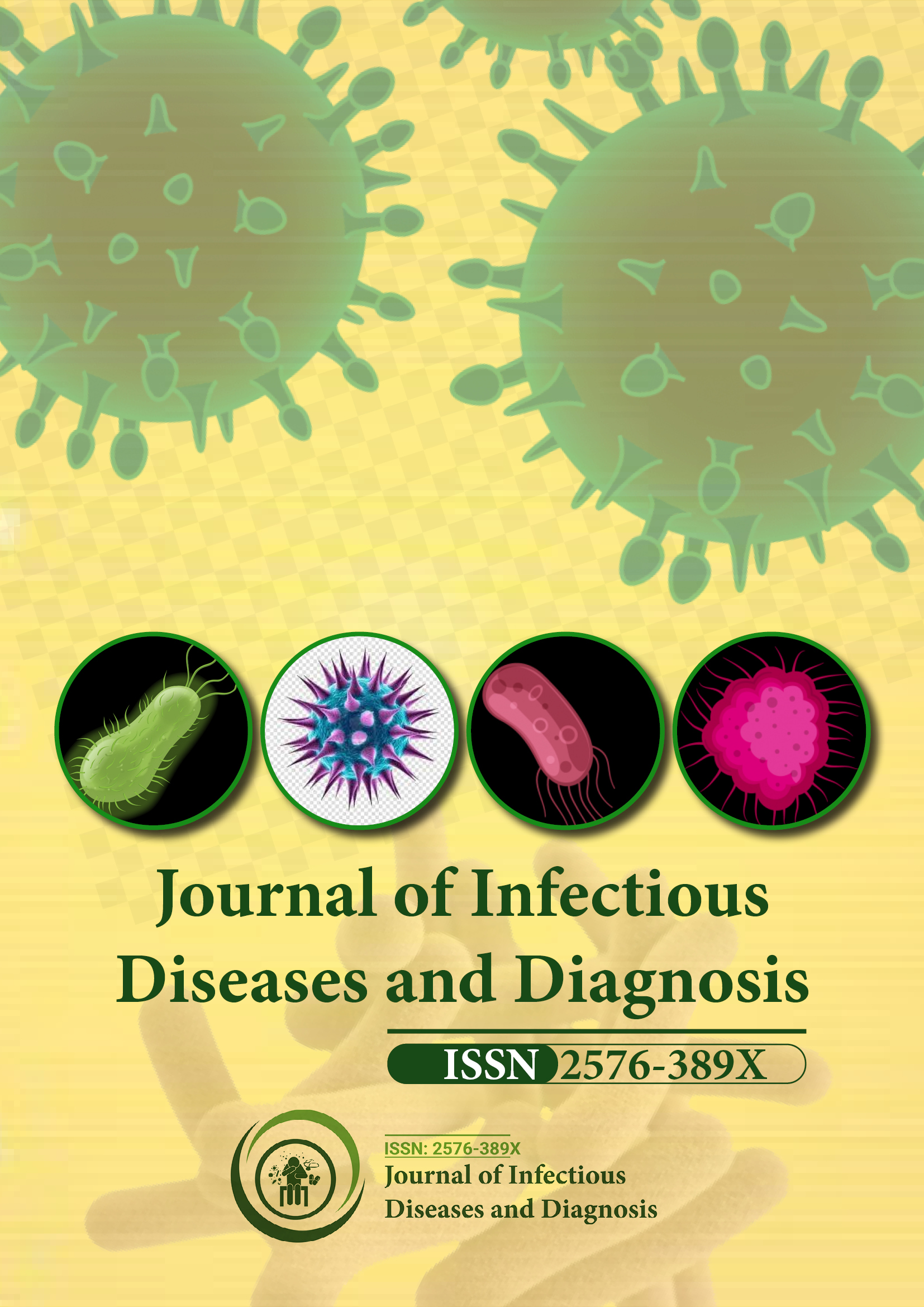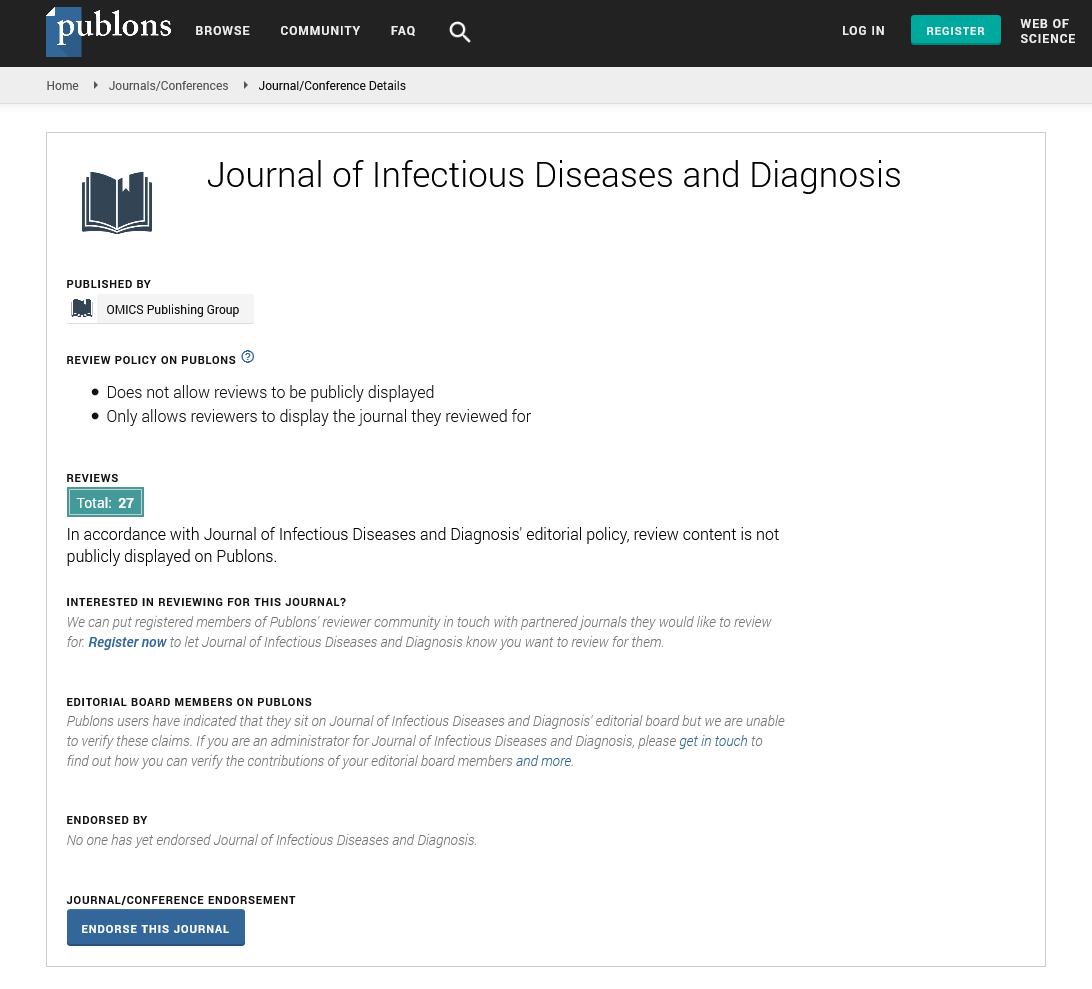Indexed In
- RefSeek
- Hamdard University
- EBSCO A-Z
- Publons
- Euro Pub
- Google Scholar
Useful Links
Share This Page
Journal Flyer

Open Access Journals
- Agri and Aquaculture
- Biochemistry
- Bioinformatics & Systems Biology
- Business & Management
- Chemistry
- Clinical Sciences
- Engineering
- Food & Nutrition
- General Science
- Genetics & Molecular Biology
- Immunology & Microbiology
- Medical Sciences
- Neuroscience & Psychology
- Nursing & Health Care
- Pharmaceutical Sciences
Perspective - (2022) Volume 7, Issue 5
Plasmodium falciparum Infection Multiplicity and Mosquito Infectivity
Rui Henriques*Received: 02-Sep-2022, Manuscript No. JIDD-22-18512; Editor assigned: 06-Sep-2022, Pre QC No. JIDD-22-18512 (PQ); Reviewed: 20-Sep-2022, QC No. JIDD-22-18512; Revised: 27-Sep-2022, Manuscript No. JIDD-22-18512 (R); Published: 04-Oct-2022, DOI: 10.35248/2576-389X.22.07.183
About the Study
Malaria is a significant public health concern in Sub-Saharan Africa. In many malaria-endemic areas, asymptomatic P. falciparum gametocyte carriers are potential infectious reservoirs for sustaining transmission. The study's goal was to determine the prevalence of gametocyte carriage and some of the risk factors associated with it among asymptomatic school children (aged 5-15 years), and to investigate the relationship between gametocyte density, Multiplicity of Infection (MOI), and mosquito infection prevalence.
In many regions, including Sub-Saharan Africa, the intensification of global and local malaria control measures has resulted in remarkable reductions in disease burden. Between 2000 and 2015, the incidence and prevalence of P. falciparum clinical cases decreased by 40% and 50%, respectively, on the African continent. Recent data, however, suggests that this trend may be reversing, with an estimated 213 million malaria cases and 380,700 related deaths in the World Health Organization (WHO) African Region between 2017 and 2018, an increase from previous years. Malaria is clearly still a serious public health issue on the continent, threatening the lives of many people, particularly children and pregnant women. P. falciparum is the dominant parasite species, as it is in many other African countries, with approximately 70.2% of the population at risk of the disease. Malaria is one of the leading causes of hospital admissions and death in the country, accounting for approximately 30% of outpatient and 19% of inpatient cases, with an estimated inpatient death rate of 3%-5%.
Malaria parasite transmission from humans to mosquito vectors is dependent on the presence of infectious mature gametocytes in the human host's peripheral blood. Because gametocytes play such an important role in the spread of malaria, their prevalence and density are frequently used as surrogate indicators for disease transmission potential. Because of the development of highly sensitive molecular tools, we now know that every malaria parasite positive individual is a current or prospective gametocyte producer, and thus has some transmission potential. In malaria endemic and high transmission areas, studies have found that children have higher asexual parasite and gametocyte prevalence and densities than adults. Because of repeated parasite exposure in such high malaria transmission areas, older children and adults develop parasite immunity. As a result, this population is more likely to develop asymptomatic infections containing gametocytes at microscopic and sub-microscopic densities, thereby serving as efficient parasite reservoirs for sustaining malaria transmission. In some malaria-endemic areas, there has been evidence of a high prevalence of asymptomatic infections and gametocyte densities in schoolchildren. Because of the lack of clinical manifestation, asymptomatic malaria infections in schoolchildren go undiagnosed and untreated. As a result, the majority of current malaria interventions and control programs largely ignore this population. Furthermore, despite a reduction in malaria burden in many endemic areas, data on the prevalence of asymptomatic P. falciparum infections and gametocyte carriage in schoolchildren, particularly in remote settings in Sub-Saharan Africa, remains patchy. Because asymptomatic infections and the prevalence of gametocyte carriage in schoolchildren may significantly impede malaria control and elimination efforts in Sub-Saharan Africa, it is critical to investigate the dynamics and infectivity of asymptomatic carriers.
The presence of gametocytes in the human host's peripheral blood does not always imply mosquito infectivity. Human attractiveness and exposure to mosquito vectors, host and vector immune responses, seasonality, gametocyte maturity and densities, and multiplicity of infection are some of the major factors that influence the successful transmission of P. falciparum gametocytes to Mosquito Vectors (MOI). The number of distinct parasite clones infecting a host at the same time is referred to as the MOI. The relationship between MOI and P. falciparum gametocytemia is still unknown, but studies have found a link between MOI and gametocyte carriage. It has been reported that the presence of genetically diverse multiple P. falciparum clones increases the chances of some parasite clones evading host antiparasite immune responses, thereby promoting gametocyte development and persistence. Some studies have found a link between P. falciparum mosquito infection rates and gametocyte density, especially at high gametocyte concentrations. However, at low gametocyte concentrations, there is a varying and less strong association. The transmission potential is now shown to be influenced by the parasite sex ratio and can be estimated using (male and female) gametocyte density. However, the proportion of variation in mosquito infection prevalence that can be explained by gametocyte density and infection multiplicity has yet to be thoroughly investigated.
The prevalence of varying levels of gametocyte carriage among different age categories due to anti-parasite immunity and high rates of polyclonal infections are two common characteristics of asymptomatic malaria infections in endemic settings. Interventions aimed at interrupting disease transmission through efficient and effective identification and treatment of both asymptomatic and symptomatic parasite carriers will be critical in the long run. Understanding the relationship between gametocyte density, MOI, and mosquito infectivity will aid in the proper identification of parasite reservoirs responsible for the region's ongoing malaria transmission. We report on the prevalence of gametocyte carriage and some of the risk factors associated with it among asymptomatic school children (aged 5-15 years), and examine the relationship between gametocyte density, MOI, and mosquito infection prevalence (percentage of infected mosquitoes).
Malaria prevalence and gametocyte carriage are high among asymptomatic schoolchildren in the region, particularly among the younger age group (5-9 years). The relatively stable and yearround prevalence of gametocyte carriage among study participants suggests that schoolchildren play an important role in maintaining malaria transmission in the study area. The statistically significant and positive combined effect of the explanatory variables on the prevalence of mosquito infection will aid in identifying human infectious reservoirs in various malaria endemic settings. Malaria control interventions that are highly effective in reducing multiple clone parasite carriage and gametocyte density may aid in disrupting parasite transmission and thus facilitating the eventual elimination of the disease in the region.
Citation: Henriques R (2022) Plasmodium falciparum Infection Multiplicity and Mosquito Infectivity. J Infect Dis Diagn. 7:183.
Copyright: © 2022 Henriques R. This is an open-access article distributed under the terms of the Creative Commons Attribution License, which permits unrestricted use, distribution, and reproduction in any medium, provided the original author and source are credited.

